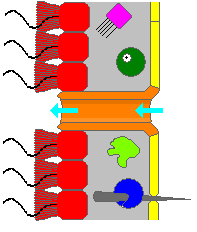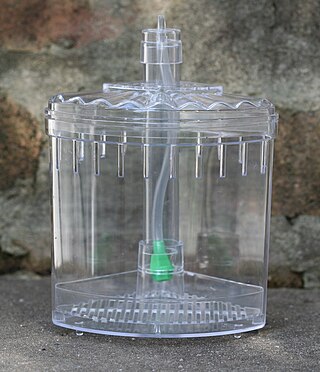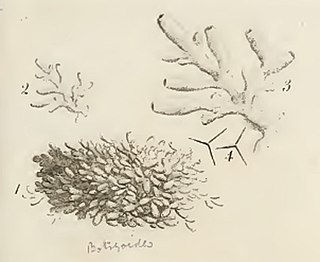
Archaeocyatha is a taxon of extinct, sessile, reef-building marine sponges that lived in warm tropical and subtropical waters during the Cambrian Period. It is believed that the centre of the Archaeocyatha origin is now located in East Siberia, where they are first known from the beginning of the Tommotian Age of the Cambrian, 525 million years ago (mya). In other regions of the world, they appeared much later, during the Atdabanian, and quickly diversified into over a hundred families.

Sponges, the members of the phylum Porifera, are a basal animal clade as a sister of the diploblasts. They are multicellular organisms that have bodies full of pores and channels allowing water to circulate through them, consisting of jelly-like mesohyl sandwiched between two thin layers of cells.

Filter feeders are a sub-group of suspension feeding animals that feed by straining suspended matter and food particles from water, typically by passing the water over a specialized filtering structure. Some animals that use this method of feeding are clams, krill, sponges, baleen whales, and many fish. Some birds, such as flamingos and certain species of duck, are also filter feeders. Filter feeders can play an important role in clarifying water, and are therefore considered ecosystem engineers. They are also important in bioaccumulation and, as a result, as indicator organisms.
A spongocoel, also called paragaster, is the large, central cavity of sponges. Water enters the spongocoel through hundreds of tiny pores (ostia) and exits through the larger opening (osculum). Depending on the body plan of the sponge, the spongocoel could be a simple interior space of the sponge or a complexly branched inner structure. Regardless of body plan or class, the spongocoel is lined with choanocytes, which have flagella that push water through the spongocoel, creating a current.

Choanocytes are cells that line the interior of asconoid, syconoid and leuconoid body types of sponges that contain a central flagellum, or cilium, surrounded by a collar of microvilli which are connected by a thin membrane.
Porocytes are tubular cells which make up the pores of a sponge known as ostia.

Aquarium filters are critical components of both freshwater and marine aquaria. Aquarium filters remove physical and soluble chemical waste products from aquaria, simplifying maintenance. Furthermore, aquarium filters are necessary to support life as aquaria are relatively small, closed volumes of water compared to the natural environment of most fish.

Ebara Corporation is a publicly traded manufacturing company based in Tokyo, Japan which makes environmental and industrial machinery such as pumps and turbines. It is the owner of the Elliott Company in the United States and Sumoto S.r.l. in Italy. Ebara also operates through its "WaterKiosk" partnership to supply clean drinking water in Kenya.

The giant barrel sponge is the largest species of sponge found growing on Caribbean coral reefs. It is common at depths greater than 10 metres (33 ft) down to 120 metres (390 ft) and can reach a diameter of 1.8 metres. It is typically brownish-red to brownish-gray in color, with a hard or stony texture. The giant barrel sponge has been called the "redwood of the reef" because of its size and estimated lifespan of hundreds to a thousand or more years. It is perhaps the best-studied species of sponge in the sea; a population on Conch Reef, in the Florida Keys, has been monitored and studied since 1997.
Arturia hirsuta is a species of calcareous sponge from South Africa. The name refers to the hispid surface of the sponge.

Clathrina lacunosa is a species of calcareous sponge from the British Isles. The species name means "having holes" and refers to the perforations found in the sides of the sponge. It is usually found on vertical solid surfaces at depths down to 220 m. It is distributed in the north-eastern Atlantic from the Arctic to the Mediterranean. It is a fairly common sponge but is often overlooked due to its small size.

Arturia sueziana is a species of calcareous sponge from Egypt. The species is named after the Egyptian city of Suez where the holotype was discovered.

Sycon raphanus is a species of marine invertebrate, a calcareous sponge belonging to the family Sycettidae. The name derives from the Greek, "raphanus", meaning radish, and presumably refers to the sponge's shape.

Tectitethya crypta is a species of demosponge belonging to the family Tethyidae. Its classified family is characterized by fourteen different known genera, one of them being Tectitethya. It is a massive, shallow-water sponge found in the Caribbean Sea. This sponge was first discovered by Werner Bergmann in 1945 and later classified by de Laubenfels in 1949. It is located in reef areas situated on softer substrates such as sand or mud. Oftentimes, it is covered in sand and algae. This results in an appearance that is cream colored/ gray colored; however, when the animal is washed free of its sediment coverings, its body plan appears more green and gray. It's characterized with ostia peaking out of its body cavity, with the ability to abruptly open or close, changing its desired water flow rate through its mesohyl.
Agelas schmidti, commonly known as the brown tubular sponge, is a species of demosponge. It occurs at moderate depths in the Gulf of Mexico and the Caribbean Sea and often has a colonial coral growing over the surface. The type locality is Puerto Rico.
Iotrochota birotulata, commonly known as the green finger sponge, is a species of sea sponge in the family Iotrochotidae. It is found in shallow waters in the Caribbean Sea.
Aplysina insularis, commonly known as the yellow-green candle sponge or yellow candle sponge, is a species of sea sponge found on reefs in the Caribbean Sea and the Gulf of Mexico.

Callyspongia truncata is a species of marine sea sponge. Like all marine sponges, C. truncata is a member of phylum Porifera and is defined by its filter-feeding lifestyle and flagellated choanocytes, or collar cells, that allow for water movement and feeding. It is a species of demosponge and a member of Demospongiae, the largest class of sponges as well as the family Callyspongiidae. C. truncata is most well known for being the organism from which the polyketide Callystatin A was identified. Callystatin A is a polyketide natural product from the leptomycin family of antibiotics. It was first isolated in 1997 from this organism, which was collected from the Goto Islands in the Nagasaki Prefecture of Japan by the Kobayashi group. Recent studies have revealed numerous other bioactive compounds that have been found in this species.

Oscarella lobularis is a species of sponge in the order Homosclerophorida. It is native to the northeastern Atlantic Ocean and the Mediterranean Sea, where it forms encrusting colonies on rocks and other hard surfaces.

The orange pipe sponge, sometimes referred to as the orange pipe calcerous sponge or Leucosolenia botryoides, is a soft, white sponge with a tubular branching structure. The name is derived from the Greek word, "botrys", which means "cluster of grapes", relating to the branched structure of the sponge. It was originally found and named Spongia botryoides and given the common name "grape sponge" by researchers John Ellis and Daniel Charles Solander in 1786 before it was discovered to be a part of the genus Leucosolenia and changed to the orange pipe sponge. In Ellis and Solander's discovery, they described the sponge as "tender and branched as in bunches" where the "bunches are hollow." It is considered an asconoid sponge because it has no definitive shape.














